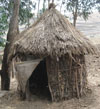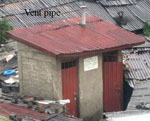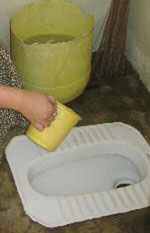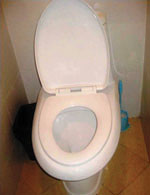18.3.1 Liquid waste management
Liquid waste management will include both onsite sanitation and offsite treatment and disposal methods. The most usual method of onsite liquid waste containment in rural Ethiopia is the pit latrine. Pit latrines are simple drop-and-store systems in which the liquid waste collects in a pit below. There are many different designs of pit latrine (Figure 18.3 and Figure 18.4), which are described in more detail in Study Session 20.
 |  |
| Figure 18.3 A traditional pit latrine. (Photo: Worku Tefera) | Figure 18.4 Ventilated improved pit (VIP) latrine. (Note the vent pipe emerging through the roof). (Photo: Worku Tefera) |
In places where water is more easily available, typical methods are drop-flush-and-discharge systems, also known as water carriage systems, such as the pour-flush latrine (Figure 18.5) or a water closet (WC) (Figure 18.6).
 |  | |
| Figure 18.5 Pour-flush latrine. (Photo: Eawag) | Figure 18.6 Water closet (WC) toilet. (Photo: Worku Tefera) |
Wastewater from water carriage systems may be piped into a septic tank or into a community or municipal treatment system, if one exists. The various types of latrine and methods of liquid waste management are discussed in more detail in Study Sessions 19 and 20.
18.3 Main components of waste management
